Australian scientists at the Thylacine Integrated Genome Restoration Research Laboratory are confident they can bring the now-extinct Tasmanian wolf back to life. To achieve this goal, the researchers will use genetic sequencing, a technology elaborated in their labs thanks to the generosity of donations totaling more than $3.6 million.
While this story may be reminiscent of the movie Jurassic Park, where scientists create a serious problem by resurrecting an already extinct species, the return of the Tasmanian wolf – also known in some languages as the Tasmanian tiger – is viewed with enthusiasm, as it could help correct critical wrongs that It is caused by colonization in the ecosystem of regions of Oceania, such as Tasmania.
The last Tasmanian wolf dies

Benjamin was the last known Tasmanian wolf. He lived in an Australian zoo and died in 1936. The reason for the extinction of this animal was hunting. At the time, farmers believed that this animal had the ability to be a predator for livestock, especially sheep. So they began a war on animals, which ended with the death of only the last of them.
As the popular saying goes, “Appearances can be deceiving.” Studies developed by researchers at the University of New South Wales, in Sydney, showed that these animals never had the potential to be a problem for farmers, as they had a small jaw, unable to kill a large animal, such as a sheep. This characteristic made the life of these animals more difficult. They needed to hunt a lot of small animals to get a proper diet.
Efforts to bring back the Tasmanian wolf from death
To try to bring this animal back to life, the researchers needed access to a living cell from an animal that resembled the Tasmanian wolf, in this case, a dunnart, a type of marsupial rodent. Then, that cell is changed so that it becomes a Tasmanian wolf cell, and then it is cloned.
If successful, this process could generate an embryo that would be transplanted into another animal to serve as a surrogate. This process, according to scientists, can generate healthy individuals, able to live in nature. Researchers believe that the first specimens of these animals will roam freely within 10 years.
The importance of Tasmanian wolves to the ecosystem

Not all of that effort has been made because scientists think Tasmanian wolves are cute. What happens is that without these predators, there would have been a disturbance in the ecosystem that caused problems for many species, like the Tasmanian devil.
Many Tasmanian devils had tumors. This is because without predators, more sick individuals are able to reproduce, which increases the number of animals susceptible to this disease. The problem is driving this animal to extinction – and this is just one example of the disturbances caused by this imbalance in the environment in which they live.

“Wannabe internet buff. Future teen idol. Hardcore zombie guru. Gamer. Avid creator. Entrepreneur. Bacon ninja.”

